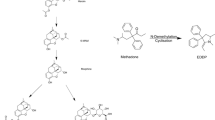Abstract
The levels of dihydrocodeine found in impaired individuals and in fatalities show a wide overlap in the ranges. Among other factors, the genetically controlled metabolism of dihydrocodeine should play an important role in dihydrocodeine toxicity.
For the first time, the most important metabolites of dihydrocodeine were investigated in femoral blood from three fatal cases by simultaneous determination using HPLC and native fluorescence for detection. The amount of parent drug always exceeded dihydrocodeine-glucuronide formation and dihydromorphine concentrations ranged from 0.16–0.21 mg/L. The similar binding affinities of dihydromorphine and morphine to μ-opioid receptors suggest similar pharmacological effects and adverse reactions. The determination of the pharmacologically active metabolites should help to clarify the cause of death in fatal cases especially if a relatively low concentration of the parent drug is found.
Similar content being viewed by others
Author information
Authors and Affiliations
Additional information
Received: 6 April 1998 / Received in revised form: 9 June 1998
Rights and permissions
About this article
Cite this article
Klinder, K., Skopp, G., Mattern, R. et al. The detection of dihydrocodeine and its main metabolites in cases of fatal overdose. Int J Leg Med 112, 155–158 (1999). https://doi.org/10.1007/s004140050222
Issue Date:
DOI: https://doi.org/10.1007/s004140050222




